The most common problem with choosing a bike for your child is figuring out the right size. No wonder that the number one question we receive has to do with how to choose a kids’ bike size.
Honestly, the answer is not as straightforward as it seems.
Unlike adult bikes, which are sized by frame size, kids’ bikes are sized by wheel diameter, starting from balance bikes with 10 or 12-inch wheels and going all the way to 26″ bikes for teens.
But there’s a big catch – two bikes with the same wheel size can be suitable for different kids, due to other measurements such as standover height and seat height.
So the only solution would be to resort to trial-and-error or have your child try the bike, right? Not really, there’s a simpler and much faster way.
After already assisting hundreds of parents, we’ve gathered four key steps in our kids’ bike sizing guide to aid you in selecting the ideal bike size for your child on the first try.
Let’s begin by taking a closer look at the first one!
Contents
- Step 1: Narrow Down the Wheel Size Based on Age and Height
- Step 2: Measure Your Child’s Inseam Length
- Step 3: Narrow Down Further Based on Leg Length
- Step 4 (Final): Choose Based on Kid’s Cycling Ability and Bike’s Specs
- A Simple Formula You Can Use
- How to Choose When They’re In Between Sizes?
- Frequently Asked Questions
- Final Thoughts
- Ready to Buy Your Kids’ New Bike?
Step 1: Narrow Down the Wheel Size Based on Age and Height
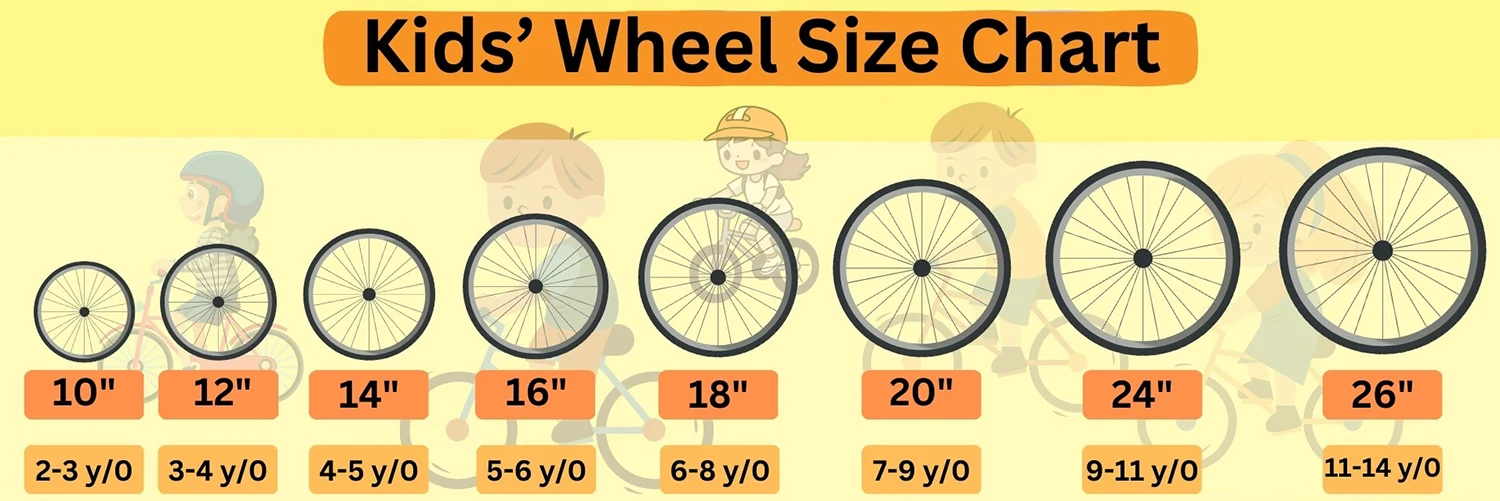
A lot of parents ask us questions such as “What size bike for a 5-year-old?”, “What size bike for a 6-year-old?” or “What size bike for a 7-year-old?”.
The reason why these questions are so common is that choosing the right child’s bike size based on age and wheel size is the simplest method you can use.
Namely, kids’ bike sizes are determined by the diameter of the wheel. Therefore, each wheel size roughly corresponds to a certain age group, as well as a certain inseam and child’s height range.
Related reading:
24-Inch Bikes for What Size Person?
26-Inch Bikes for What Size Person?
That allows us to create a simple bike size chart that will help us to narrow down the correct wheel size based on age and body measurements.
Kids’ Bike Size Chart
Wheel Size |
Age |
Height (In) |
Height (Cm) |
Leg Inseam (In) |
Leg Inseam (Cm) |
| 10″ | 2-3 | 2’9″ – 3’1″ | 85-90 cm | 12″ – 14″ | 85 – 90 cm |
| 12″ | 3-4 | 3’1″ – 3’3″ | 90-100 cm | 14″ – 17″ | 35 – 42 cm |
| 14″ | 4-5 | 3’3″ – 3’7″ | 100-110 cm | 16″ – 20″ | 40 – 50 cm |
| 16″ | 5-6 | 3’7″ – 3’8″ | 110-115 cm | 18″ – 22″ | 45 – 50 cm |
| 18″ | 6-8 | 3’8″ – 4’0″ | 115-120 cm | 20″ – 24″ | 50 – 60 cm |
| 20″ | 7-9 | 4’0″ – 4’5″ | 120-135 cm | 22″ – 25″ | 55 – 63 cm |
| 24″ | 9-11 | 4’5″ – 4’9″ | 135-145 cm | 24″ – 28″ | 60 – 72 cm |
| 26″ | 11-14 | 5’+ | 145 cm + | 28″+ | 72 cm+ |
It’s important to keep in mind that this method works in most cases as kids generally grow at the same pace. But, as always in life, there are exceptions to this rule.
We recommend using the chart above as a starting point that will point you in the right direction. But we advise against relying solely on it.
Instead, once you’ve roughly narrowed down your kids’ bike size, you can start looking at some potential models you might want to buy in that size and checking for measurements such as:
- Standover height and,
- Minimum/maximum seat height.
Step 2: Measure Your Child’s Inseam Length
Bike manufacturers of the best kids’ bikes usually have informative size charts or detailed geometry charts that include information about the bike’s standover height and minimum/maximum seat height. Good examples include Woom and Strider. If the product page of the bike you’re interested in doesn’t include this information, we advise against buying that bike.
Why do these measurements matter?
They tell us how the bike fits a child based on its inseam length, which is the most reliable method for choosing a kid’s bike size and getting the best fit.
But, what you need to do first is measure your kid’s leg inseam length.
How to Measure Inseam Length?
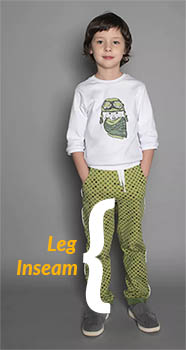
To measure your child’s inseam, have them stand with their back against a wall, wearing shoes they will typically be using for biking.
Next, place a book between their legs and flush against the wall. Tell them to hold it as close to their crotch as possible for the most precise results.
Then, using a measuring tape, measure the distance from the floor, to the top of the book in inches.
If your measuring tape only shows centimeters, you can simply divide the result by 2.54 to convert it to inches (for example, 40 cm divided by 2.54 equals 15.75 inches).
Now that you know your child’s leg length, you can compare it against bikes’ standover heights and minimum/maximum seat heights to really pinpoint the right bike size and ensure your child feels comfortable, safe, and confident while riding it.
Step 3: Narrow Down Further Based on Leg Length
Now that you know your kid’s leg length in inches, you’re ready to really narrow down your choices by considering the bike’s geometry and sizing charts.
As mentioned above, measurements such as standover height and min./max. seat height tell us how the bike will fit a child based on their inseam length.
Why does standover height matter?
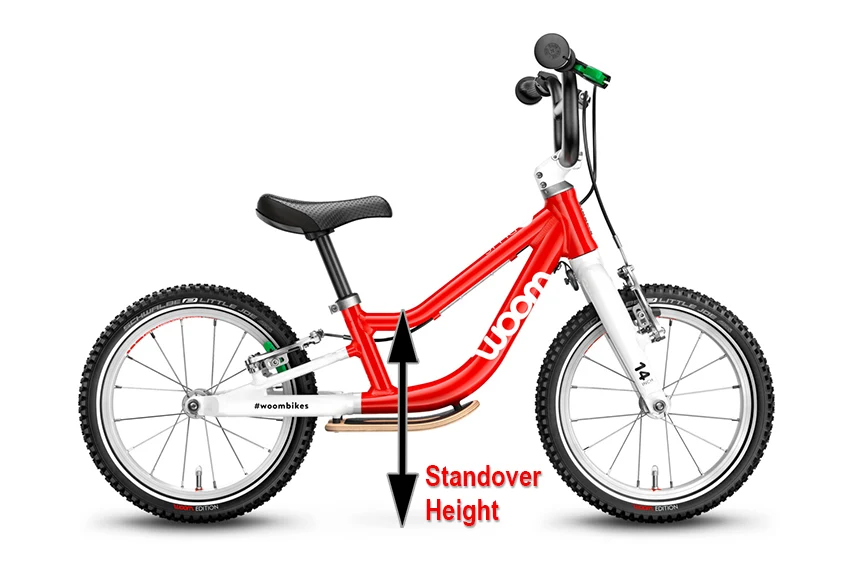
Standover height is the distance from the top tube of the bike to the floor.
With the right standover height, your kid will be able to safely dismount the bike whenever necessary and feel stable and in full control.
There’s nothing worse for confidence than a bike that feels too big and doesn’t let you touch the ground with your feet.
Ideally, your child’s inseam should be at least the same length or 1-2 inches longer than their bike’s standover height.
Still, accidents and mistakes can happen, especially at an early age, so make sure your child is always wearing a high-quality kids’ bike helmet.
Why does seat height matter?
The seat height measurement tells us how easy it will be for a child to place their feet flat on the ground while sitting on the saddle. Children need to be able to do this easily to feel safe and comfortable while riding, especially if they are a beginner.
Roughly speaking, if your child is inexperienced and getting their first bike (especially if we’re talking about a balance bike), their inseam length should be the same as the bike’s minimum seat height (or 1-2 inches longer).
If they are more experienced and getting their second bike, their inseam length can be 1-3 inches shorter than the bike’s minimum seat height, so they can reach the floor on tiptoes while seated instead of with feet flat on the ground. This way, they will still feel comfortable and safe, but they’ll be able to pedal more easily and use the bike comfortably for longer.
Step 4 (Final): Choose Based on Kid’s Cycling Ability and Bike’s Specs
The final and most important step in choosing the right kids’ bike size is considering all the information above relative to your child’s cycling ability and bike’s specs.
For that reason, we’ve split all potential riders into three categories:
- Inexperienced rider buying a first balance bike
- Inexperienced rider buying a first pedal bike
- Experienced rider buying a second pedal bike
Here’s how this information will help you NAIL the right size.
1. Buying a First Balance Bike (Inexperienced Rider)
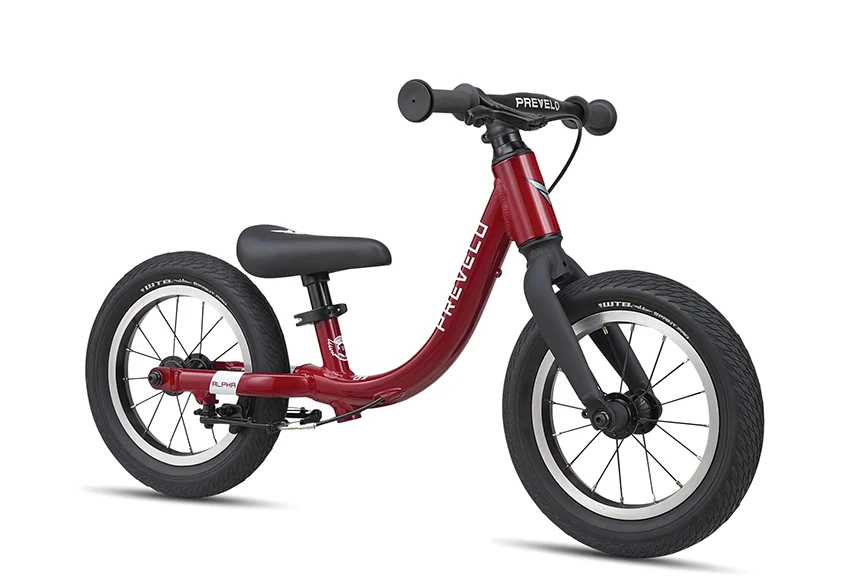
Young children and toddlers should start their cycling journey on balance bikes without training wheels, as they offer the most natural way of learning. If you want to know why, you can read our detailed guide on balance bikes.
Considering this is their first two-wheeler, the main priorities should be confidence, comfort, and safety. That means buying a bike for their current growth with a minimum seat height that is at least the same length as their inseam length or one inch shorter.
This way, your child will be able to reach the ground comfortably and scoot, which will boost their confidence and help them stay safe while pushing against their ground with their feet.
2. Buying a First Pedal Bike (Inexperienced Rider)
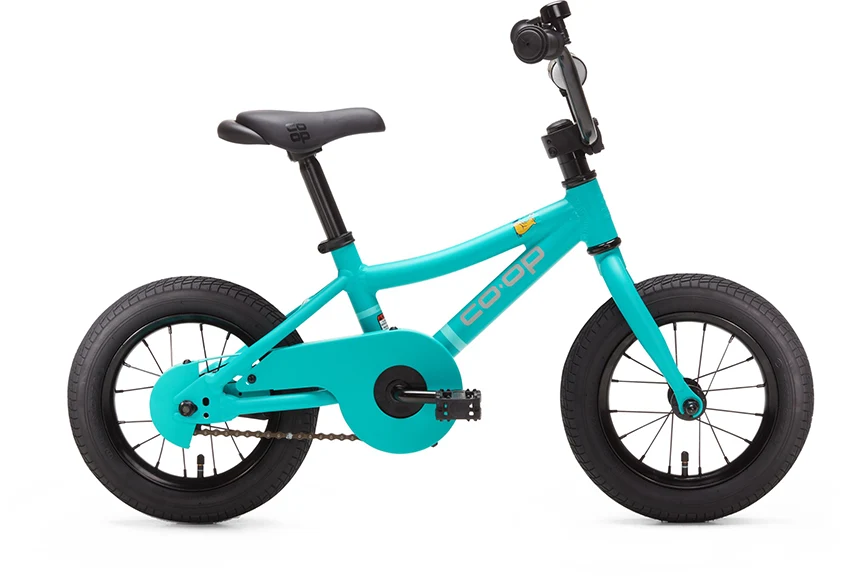
If you’re buying a first pedal bike for a child who is transitioning from a balance bike or who is still learning how to ride, the approach to sizing should be more or less the same as above.
That means that the minimum seat height should ideally be the same as the child’s leg length, but it can be one inch shorter or longer depending on your child’s experience.
A child moving from a balance bike can handle a seat height one inch above their leg length.
On the other hand, first-time pedal bike riders without balance bike experience should have a seat height equal to or one inch below their leg length.
For a child’s first pedal bike, match the seat height to their experience: equal or one inch below leg length for beginners, and one inch above for those transitioning from a balance bike.
Riding a pedal bike for the first time is a completely different experience from riding a balance bike, so children need some time to get used to the new motions and build confidence.
You should also get a bike with simple parts, such as a coaster brake or one hand brake, and a single-speed drivetrain.
Learning how to pedal, brake and shift gears at the same time can feel overwhelming for a young rider. Read more about this idea in our guide on how to choose a kids’ bike.
3. Buying a Second Pedal Bike (Experienced Rider)
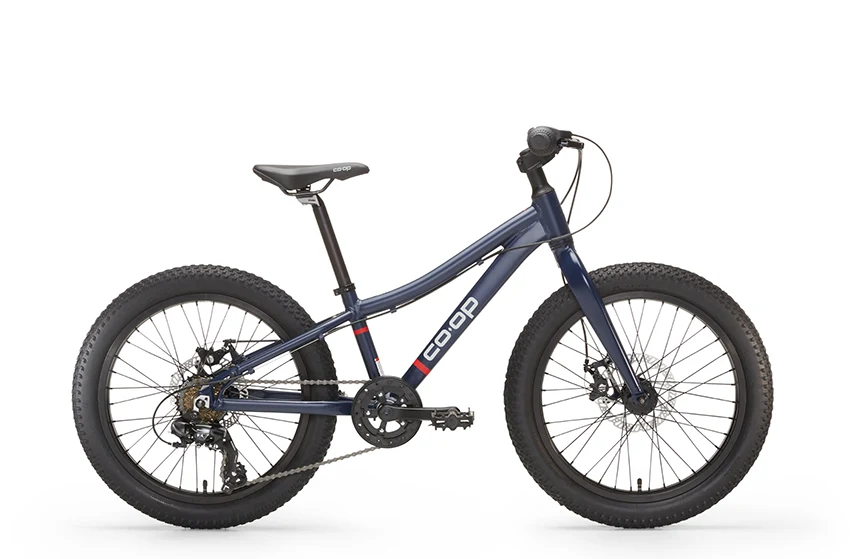
More experienced riders who are getting their second pedal bike are most likely already used to pedaling and balancing on two wheels.
In this case, the minimum seat height can be 1″-3″ longer than their inseam length, which would allow them to reach the ground on tiptoes while seated on the saddle.
Moreover, this is the right time to start incorporating more complex features such as front and rear hand brakes and multi-speed drivetrains with shifters.
At this point, your kiddo will feel confident while pedaling the bike if the sizing is right, so they can pay attention to other aspects of riding a bike, such as braking and shifting.
A Simple Formula You Can Use
Knowing what we’ve learned above about the relationship between seat height, leg length, and riding ability, we can create a simple formula that will help you choose the right kids’ bike size.
- Balance Bike: Inseam + 0 (or -1) = Minimum Seat Height
- First Pedal Bike (Inexperienced): Inseam + 0 (or -1) = Minimum Seat Height
- First Pedal Bike (Experienced): Inseam + 1 = Minimum Seat Height
- Second Pedal Bike: Inseam + 2 or 3 = Minimum Seat Height
- Next Pedal Bike (More Experience): Inseam + 3 or 4 = Minimum Seat Height
For example, if your child has an 18″ inseam and you’re buying their second pedal bike to transition from a smaller bike, the formula tells us that they need a bike with a 20″-21″ minimum seat height: 18″ (Inseam) + 2″ or 3″ (riding ability difference) = 20″ or 21″ (min. seat height).
It’s as simple as that!
How to Choose When They’re In Between Sizes?
Unfortunately, kids don’t always fit perfectly at the bottom end of the recommended inseam/height range. Sometimes, they fit at the upper end of the recommended range or right in between two sizes.
What on earth should you do then?
Don’t worry, we can employ the same logic and choose based on your child’s riding ability and confidence.
If they already know how to ride a bike and feel confident while balancing or pedaling on two wheels, you can go with the larger bike size. They’ll be able to adapt to it during the first few days or weeks of riding, and then they’ll probably grow into it in a few months.
If your child is in between bike sizes, select based on their riding ability and confidence: a larger bike for experienced riders, or a smaller one for beginners.
However, if you’re buying a first bike (balance or pedal) for your child or they have experience riding but still lack confidence, it’s best to go with the smaller size. This will allow them to feel safer and more in control while riding, even though they might outgrow the bike in a few months.
Frequently Asked Questions
What size bike do I need for my child?
You can find the right size bike by referring to a bike size chart for kids. There are different methods you can use to determine the right size, the most popular of which are inseam length, age, and tire size. Using the inseam length method is the most reliable one.
How do I choose the right bike for my child?
The first thing to consider is your child’s age. For example, a toddler bicycle and bikes for teens have different components and are differently sized. If your child doesn’t know how to ride, get them a balance bike first, and then a pedal bike with or without gears.
When should I buy my child a bike?
You can buy your child a bike as soon as they are 18 months old. Of course, at this age, a small balance bike is the best choice. Once a child is 3-4 years old, they can start riding a pedal bike, since at this age their coordination and muscle control improves significantly.
What size bike should my child ride?
To find the perfect size bike for your child, you need to take a close look at a bike size chart for kids, such as the one we have in this article. It will tell you which size to choose based on your child’s age or inseam length. To ensure you make no mistakes, it’s best to combine these two methods.
What size bike for a 3-year-old?
Three-year-olds should typically ride a bike with 12" or 14" wheels, assuming their inseam height is 14"-17" long and they are 3’1″ – 3’3″ tall. However, keep in mind that these are just rough figures and that you should take a look at our full kids' bike size chart for more information.
What size bike for a 4-year-old?
Four-year-olds should typically ride a bike with 14" or 16" wheels, assuming their inseam height is 16″-20″ long and they are 3’3″ – 3’7″ tall. However, keep in mind that these are just rough figures and that you should take a look at our full kids' bike size chart for more information.
What size bike for a 6-year-old?
Six-year-olds should typically ride a bike with 16" or 18" wheels, assuming their inseam height is 18"-22" long and they are 3’7″ – 3’8″ tall. However, keep in mind that these are just rough figures and that you should take a look at our full kids' bike size chart for more information.
What size bike for a 7-year-old?
Seven-year-olds should typically ride a bike with 18" or 20" wheels, assuming their inseam height is 20"-24" long and they are 3’8″ – 4’0″ tall. However, keep in mind that these are just rough figures and that you should take a look at our full kids' bike size chart for more information.
Final Thoughts

At first, choosing the right kids’ bike size might seem daunting and complicated — but it isn’t if you know what you’re doing.
In most cases, it should be easy to find the right size by following the four steps that we’ve described above. And we’ve also explained what to do if your child happens to be in between two sizes.
Therefore, when it comes to buying kids’ bicycles, trying the bike out before purchasing and doing a test ride is not necessary. You can find the right size by following the steps above and using some basic math.
Ready to Buy Your Kids’ New Bike?

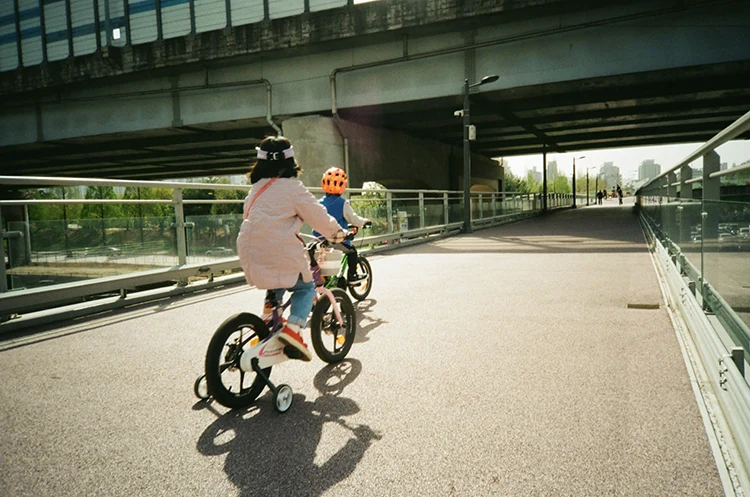
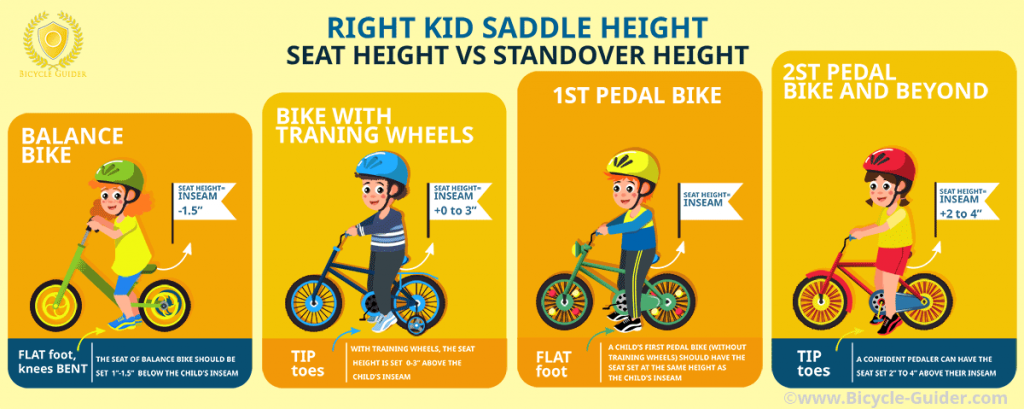
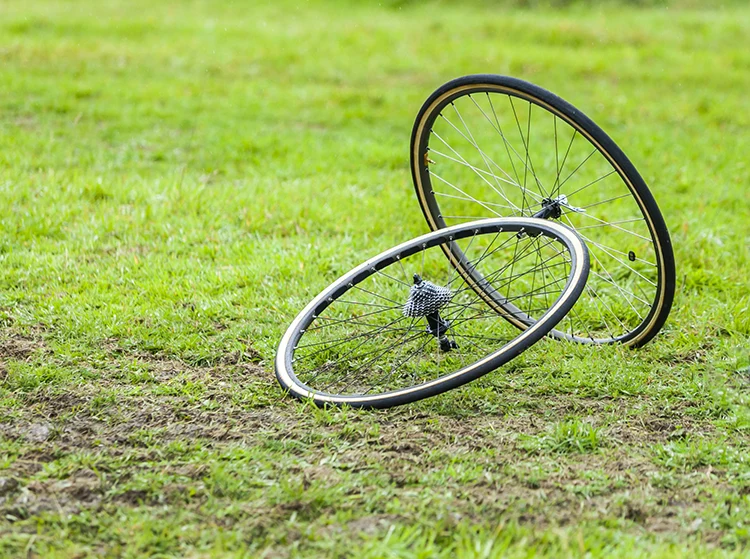
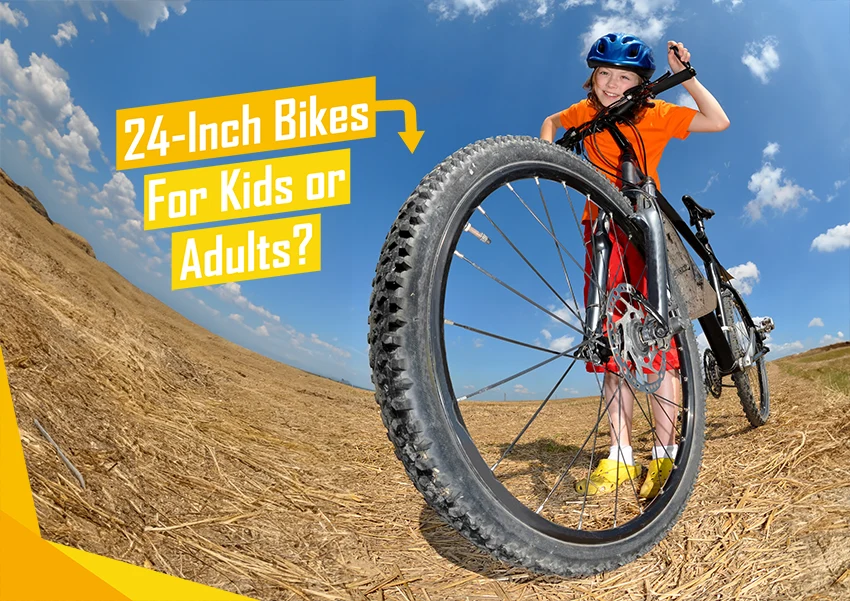
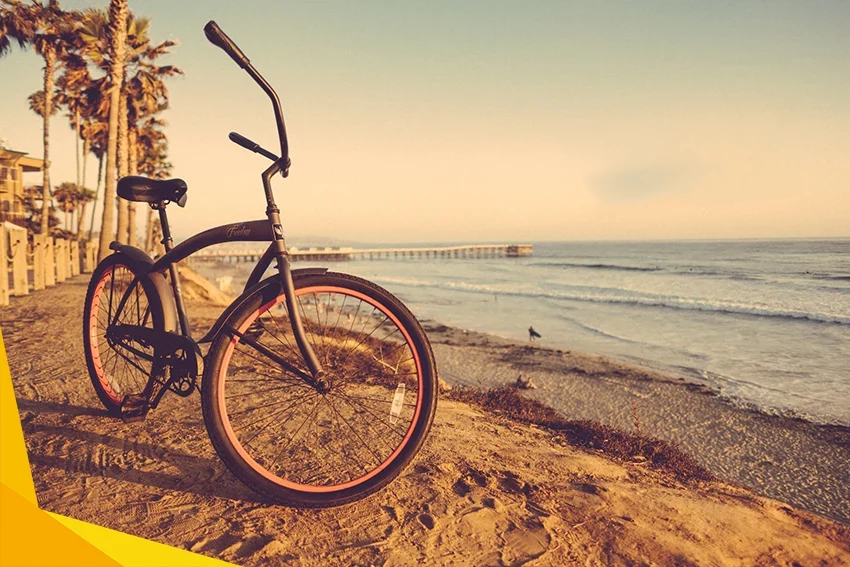
Hi. My son has outgrown his first bike. He is 4’4″ with a 22″ inseam. He turns 9 in a few weeks. We want to order a bike, but with COVID, we can’t go in and try out. We think maybe 20″, but he is also close tonthe criteria for 24″.
What do you suggest?
Hi Gina,
It’s always case to case and children don’t really have the ‘perfect’ fit. You can still make adjustments in terms of saddle height. A 22″ can be a comfortable fit for him. Check out our:
Kids Bike Sizes
I have a 10yr old son 4’9” and a 14 yr old daughter. They haven’t learn how to ride a bike. what’s the best type to learn? Also, my daughter tried my bike and states seat is uncomfortable what type of seat is recomendable? She’s 5’2” weight 175lbs.
Hi Jacqueline,
I am so happy to know you are getting your kids into cycling! Check out our The Best Kids Bikes (And How To Choose Them) Also How To Choose: Child & Baby Bike Seats
Hi, I have a question, our daughter is almost 11yo, she is petite. Her height is 4’2.5” and her inseam 24”. She is in between 20” and 24” sizes. What would you recommend? Thank you
She is at an age when she will probably start growing rapidly, so I’d go for a 24″ kids bike. No point in getting a 20″ bike that’s perhaps going to be too small for her in a few months or a year.